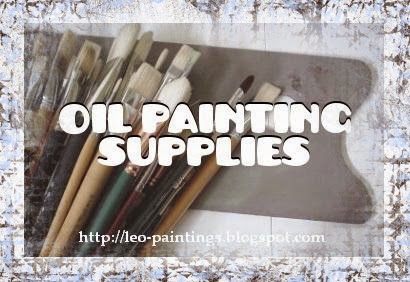This list is for artists who want to start oil painting but aren’t sure of what paint supplies to buy. All of these items can be found at any art supply store, and are absolutely necessary for beginning oil painters.
Make sure you have the right supplies
Canvas
Stretched gessoed canvases are popular . You can also use linen canvasses, which are more expensive, for finer paintings.
You can make your own canvases by buying linen in rolls and gluing them to stiff surfaces like wood panels. Be sure to gesso them before painting on them.
Buy a few different sizes and shapes. Long and thin are great for landscapes.
Easel (You can also lay your canvas flat on a table)
An easel is an upright support used for displaying and/or fixing something resting upon it, at an angle of about 20° to the vertical. In particular easels are traditionally used by painters to support a painting while they work on it, normally standing up, and are also sometimes used to display finished paintings. Artists' easels are still typically made of wood to functional designs that have changed little for centuries, if not millennia, though new materials and designs are now available.
Palette
A palette is used to hold a bit of each paint color squeezed out of the tube, with an area in the center for mixing colors. You need to decide whether you want a palette you hold in your hand or place on a table, and whether it's wooden, white, or transparent (glass). Holding a palette takes a little getting used to, but there's nothing stopping you putting it flat on a tabletop. If you need to clean up completely after each session, a disposable paper palette
Oil Paints
As far as colors go, here’s a list of the must-haves:
Titanium White, Ivory Black, Cadmium Red, Permanent Alizarin Crimson, Ultramarine Blue, Pthalo Blue, Cadmium Yellow Light, and Cadmium Yellow.
Buy each of these colors in 200ml tubes except for Pthalo Blue—Pthalo’s pretty powerful so you probably won’t need as much as you do with the others.
Technically those are all the colors you need, but you should also get a few greens and browns until you learn more about mixing colors. Pick up some Permanent Green Light, Viridian, Burnt Umber, and Burnt Sienna to round out your palette.
Alkyd Quick-Drying Mediums
If you find yourself wishing your oil paint would dry faster, then using alkyd mediums will help. These are compatible with oil paint, and do the same job as oil mediums and solvents, but are formulated to dry much more quickly. Some are formulated as gels or texture paste, to give more body to oil paint.
Different sizes of brushes
It's tempting, but truly you don't need loads of brushes in all the different sizes and shapes. You'll develop a preference for particular sizes and shape, as well as type of hair. To start, I recommend getting just two sizes of filbert brush, with stiff hairs, such as an 8 and 12. A filbert is a versatile brush shape that gives a range of strokes, from wide to narrow,
If you’re an oil painter you know that there are a lot of oil painting brushes available to choose from—big, small, square, angled, and everything in between.
Medium Containers
You'll need a container for whatever medium and/or solvent you're using, and probably another for rinsing your brush clean. An empty jam jar will do the trick, though do remember the issues of solvents and studio ventilation. One option clips onto the edge of your palette and holds a small amount of medium
Palette knife
Solvents for Oil Paints
Paint thinner, turpentine, Turpenoid ,Thinners are used to dilute oil paint and to clean your brushes and palette. The most traditional solvent is turpentine, which maintain the oiliness of oil paint. Adding white or mineral spirits to oil paints makes a watery mixture. Look for low-odor solvents and always use in a well-ventilated room. Solvents sold in hardware stores are not artist's quality and can cause yellowing.
Turpenoid is an odorless form of turpentine, but you still need to make sure your room is well ventilated when using these so-called odorless solvents. Obtain an airtight container for storing your solvents so they do not evaporate.
If you use water soluble oil paints, then regular tap water is your solvent.
Mediums for Oil Paints
Mediums are made to improve the flow of the oil paints and also the transparency and gloss of the final oil painting.reduce drying time, and avoid overthinning. You can buy ready-mixed mediums or use various forms of linseed oil. Read the description on the bottle to see exactly what a medium does. For very thin washes, mix a medium with thinners, otherwise there may not be enough oil to bind the pigment.
Newspaper or Paper Towels
Newspaper is handy to have around when you clean your paint brushes at the end of the day, but it’s also good to use WHILE you’re painting.
Why? Because it’s important to clean your brush every time you start painting a new section or switch colors—and that‘ll happen a lot in every painting.
There’s no need to use turpentine for a full cleaning, just grab some newspaper (cut 4 inch squares ahead of time if you feel like it) and quickly squeeze all the paint out of the bristles. That’ll keep your colors from contaminating each other throughout the painting process.
Towels also can be use for cleaning brushes


No comments:
Post a Comment